Financial Management Report: Buffett's PCP Acquisition Analysis
VerifiedAdded on 2022/10/31
|8
|1348
|362
Report
AI Summary
This report provides a financial analysis of Berkshire Hathaway's (BRK) acquisition of Precision Castparts Corporation (PCP). It begins by examining investor reactions to the announcement and explores the valuation of PCP using comparable company methods. The report delves into the cost of capital, determining the appropriate hurdle rate for investment in PCP and the rationale behind using a WACC of 5.12%. It then calculates the Net Present Value (NPV) using different discount rates to assess the deal's financial viability, concluding that the acquisition was a good deal for Buffett. Finally, the report highlights Buffett's investment philosophy, emphasizing economic reality over accounting, the importance of intrinsic value, and the consideration of less efficient businesses with growth potential. The analysis draws on various financial metrics and investment principles to assess the acquisition's financial implications.
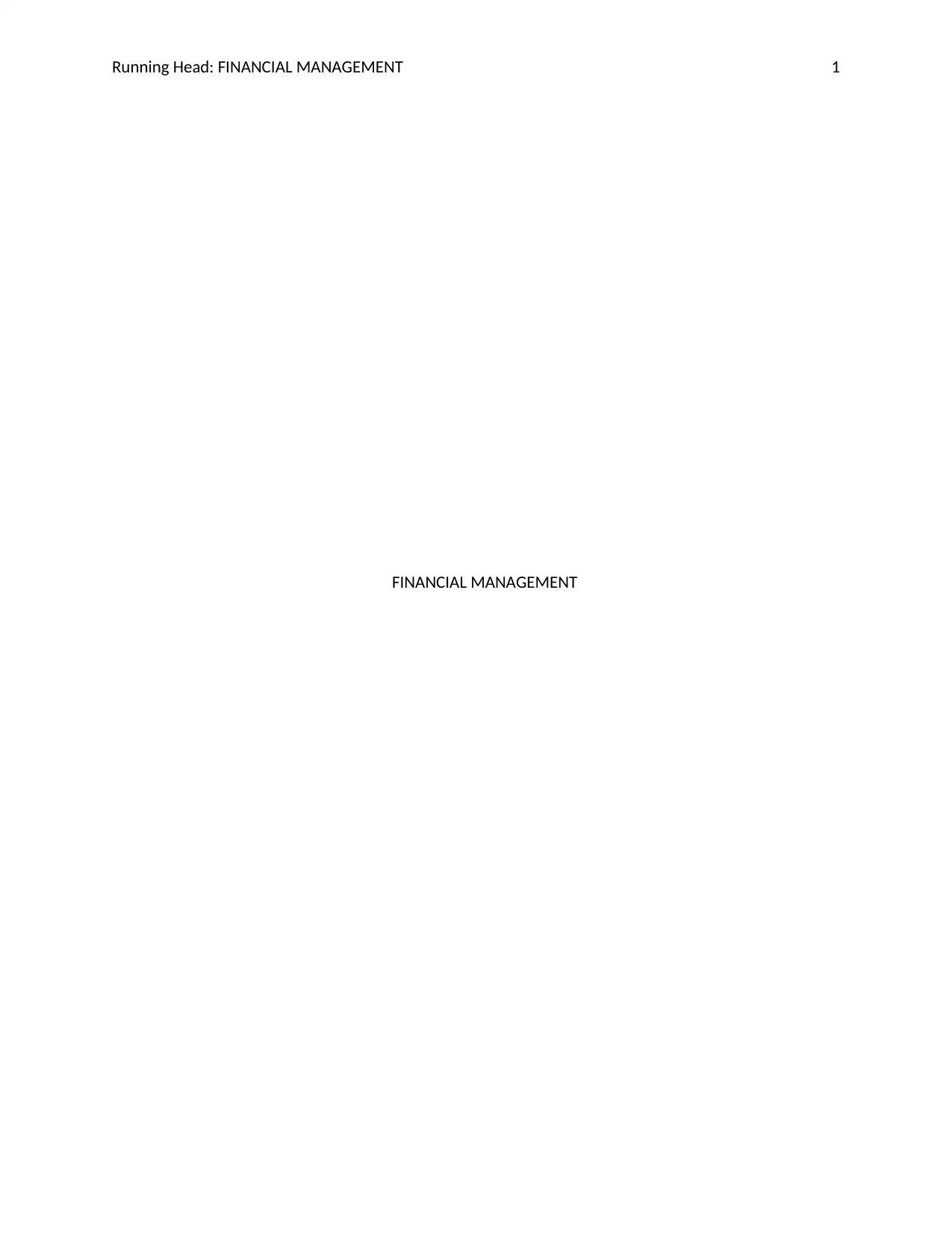
Running Head: FINANCIAL MANAGEMENT 1
FINANCIAL MANAGEMENT
FINANCIAL MANAGEMENT
Paraphrase This Document
Need a fresh take? Get an instant paraphrase of this document with our AI Paraphraser
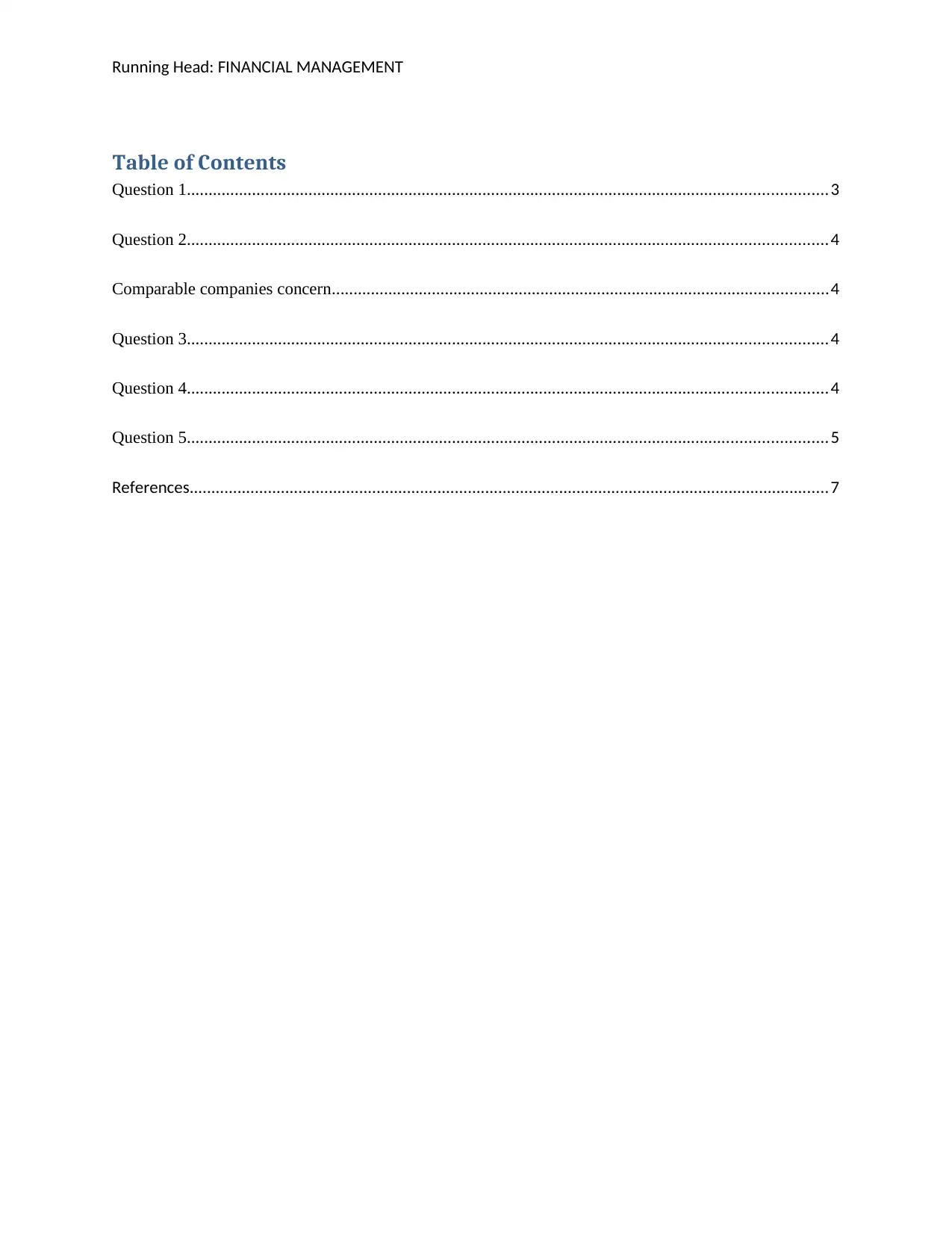
Running Head: FINANCIAL MANAGEMENT
Table of Contents
Question 1...................................................................................................................................................3
Question 2...................................................................................................................................................4
Comparable companies concern..................................................................................................................4
Question 3...................................................................................................................................................4
Question 4...................................................................................................................................................4
Question 5...................................................................................................................................................5
References...................................................................................................................................................7
Table of Contents
Question 1...................................................................................................................................................3
Question 2...................................................................................................................................................4
Comparable companies concern..................................................................................................................4
Question 3...................................................................................................................................................4
Question 4...................................................................................................................................................4
Question 5...................................................................................................................................................5
References...................................................................................................................................................7
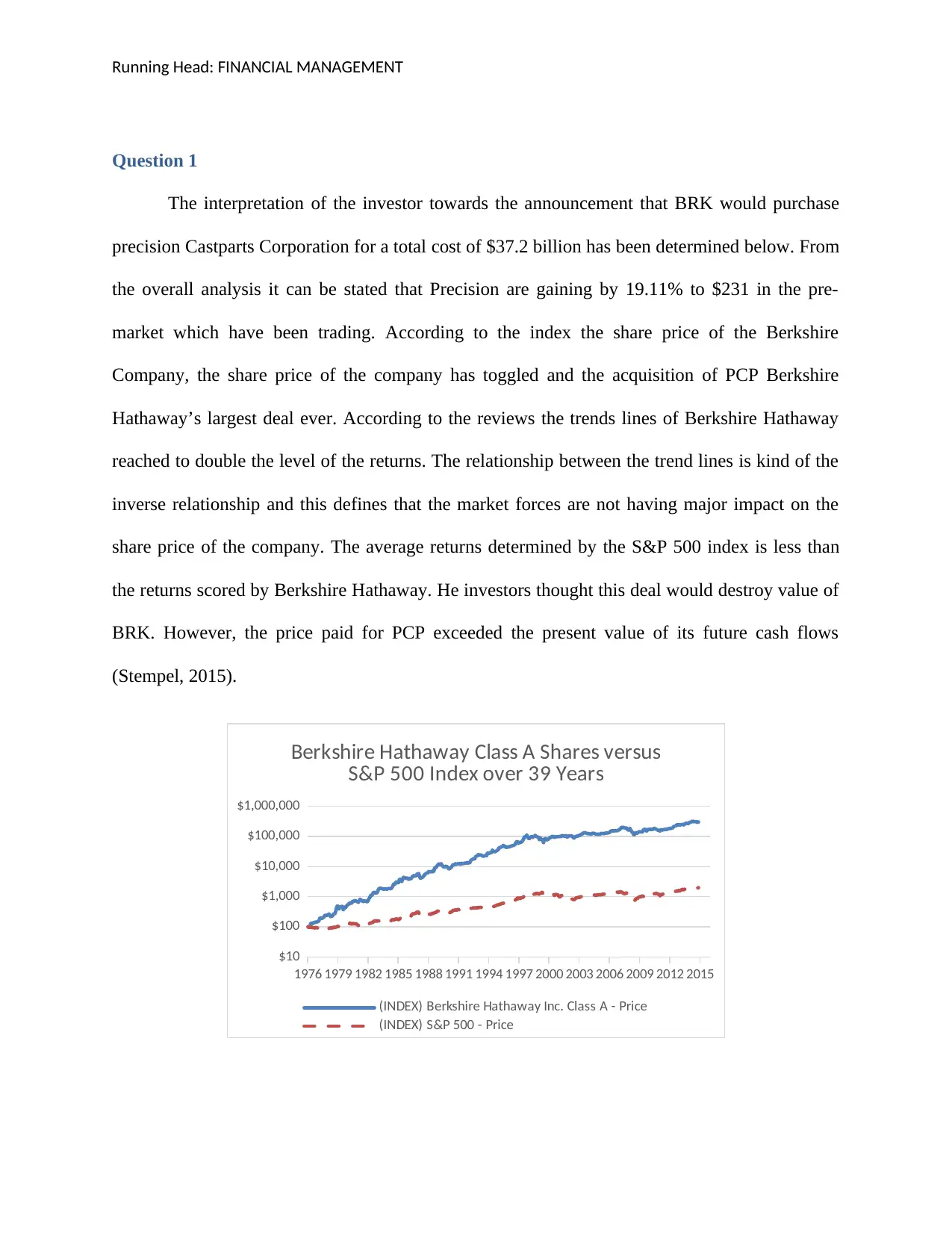
Running Head: FINANCIAL MANAGEMENT
Question 1
The interpretation of the investor towards the announcement that BRK would purchase
precision Castparts Corporation for a total cost of $37.2 billion has been determined below. From
the overall analysis it can be stated that Precision are gaining by 19.11% to $231 in the pre-
market which have been trading. According to the index the share price of the Berkshire
Company, the share price of the company has toggled and the acquisition of PCP Berkshire
Hathaway’s largest deal ever. According to the reviews the trends lines of Berkshire Hathaway
reached to double the level of the returns. The relationship between the trend lines is kind of the
inverse relationship and this defines that the market forces are not having major impact on the
share price of the company. The average returns determined by the S&P 500 index is less than
the returns scored by Berkshire Hathaway. He investors thought this deal would destroy value of
BRK. However, the price paid for PCP exceeded the present value of its future cash flows
(Stempel, 2015).
1976 1979 1982 1985 1988 1991 1994 1997 2000 2003 2006 2009 2012 2015
$10
$100
$1,000
$10,000
$100,000
$1,000,000
Berkshire Hathaway Class A Shares versus
S&P 500 Index over 39 Years
(INDEX) Berkshire Hathaway Inc. Class A - Price
(INDEX) S&P 500 - Price
Question 1
The interpretation of the investor towards the announcement that BRK would purchase
precision Castparts Corporation for a total cost of $37.2 billion has been determined below. From
the overall analysis it can be stated that Precision are gaining by 19.11% to $231 in the pre-
market which have been trading. According to the index the share price of the Berkshire
Company, the share price of the company has toggled and the acquisition of PCP Berkshire
Hathaway’s largest deal ever. According to the reviews the trends lines of Berkshire Hathaway
reached to double the level of the returns. The relationship between the trend lines is kind of the
inverse relationship and this defines that the market forces are not having major impact on the
share price of the company. The average returns determined by the S&P 500 index is less than
the returns scored by Berkshire Hathaway. He investors thought this deal would destroy value of
BRK. However, the price paid for PCP exceeded the present value of its future cash flows
(Stempel, 2015).
1976 1979 1982 1985 1988 1991 1994 1997 2000 2003 2006 2009 2012 2015
$10
$100
$1,000
$10,000
$100,000
$1,000,000
Berkshire Hathaway Class A Shares versus
S&P 500 Index over 39 Years
(INDEX) Berkshire Hathaway Inc. Class A - Price
(INDEX) S&P 500 - Price
⊘ This is a preview!⊘
Do you want full access?
Subscribe today to unlock all pages.

Trusted by 1+ million students worldwide
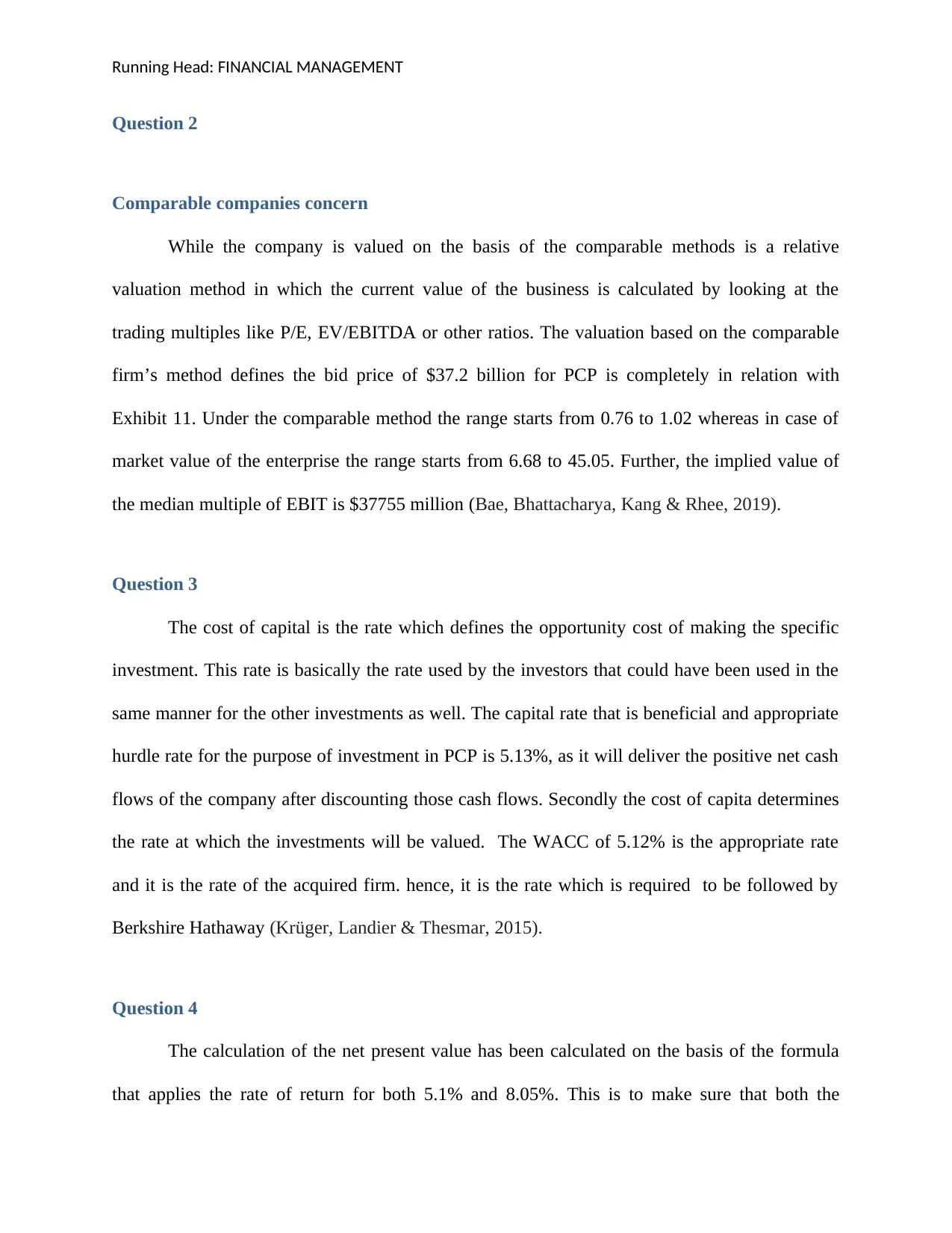
Running Head: FINANCIAL MANAGEMENT
Question 2
Comparable companies concern
While the company is valued on the basis of the comparable methods is a relative
valuation method in which the current value of the business is calculated by looking at the
trading multiples like P/E, EV/EBITDA or other ratios. The valuation based on the comparable
firm’s method defines the bid price of $37.2 billion for PCP is completely in relation with
Exhibit 11. Under the comparable method the range starts from 0.76 to 1.02 whereas in case of
market value of the enterprise the range starts from 6.68 to 45.05. Further, the implied value of
the median multiple of EBIT is $37755 million (Bae, Bhattacharya, Kang & Rhee, 2019).
Question 3
The cost of capital is the rate which defines the opportunity cost of making the specific
investment. This rate is basically the rate used by the investors that could have been used in the
same manner for the other investments as well. The capital rate that is beneficial and appropriate
hurdle rate for the purpose of investment in PCP is 5.13%, as it will deliver the positive net cash
flows of the company after discounting those cash flows. Secondly the cost of capita determines
the rate at which the investments will be valued. The WACC of 5.12% is the appropriate rate
and it is the rate of the acquired firm. hence, it is the rate which is required to be followed by
Berkshire Hathaway (Krüger, Landier & Thesmar, 2015).
Question 4
The calculation of the net present value has been calculated on the basis of the formula
that applies the rate of return for both 5.1% and 8.05%. This is to make sure that both the
Question 2
Comparable companies concern
While the company is valued on the basis of the comparable methods is a relative
valuation method in which the current value of the business is calculated by looking at the
trading multiples like P/E, EV/EBITDA or other ratios. The valuation based on the comparable
firm’s method defines the bid price of $37.2 billion for PCP is completely in relation with
Exhibit 11. Under the comparable method the range starts from 0.76 to 1.02 whereas in case of
market value of the enterprise the range starts from 6.68 to 45.05. Further, the implied value of
the median multiple of EBIT is $37755 million (Bae, Bhattacharya, Kang & Rhee, 2019).
Question 3
The cost of capital is the rate which defines the opportunity cost of making the specific
investment. This rate is basically the rate used by the investors that could have been used in the
same manner for the other investments as well. The capital rate that is beneficial and appropriate
hurdle rate for the purpose of investment in PCP is 5.13%, as it will deliver the positive net cash
flows of the company after discounting those cash flows. Secondly the cost of capita determines
the rate at which the investments will be valued. The WACC of 5.12% is the appropriate rate
and it is the rate of the acquired firm. hence, it is the rate which is required to be followed by
Berkshire Hathaway (Krüger, Landier & Thesmar, 2015).
Question 4
The calculation of the net present value has been calculated on the basis of the formula
that applies the rate of return for both 5.1% and 8.05%. This is to make sure that both the
Paraphrase This Document
Need a fresh take? Get an instant paraphrase of this document with our AI Paraphraser
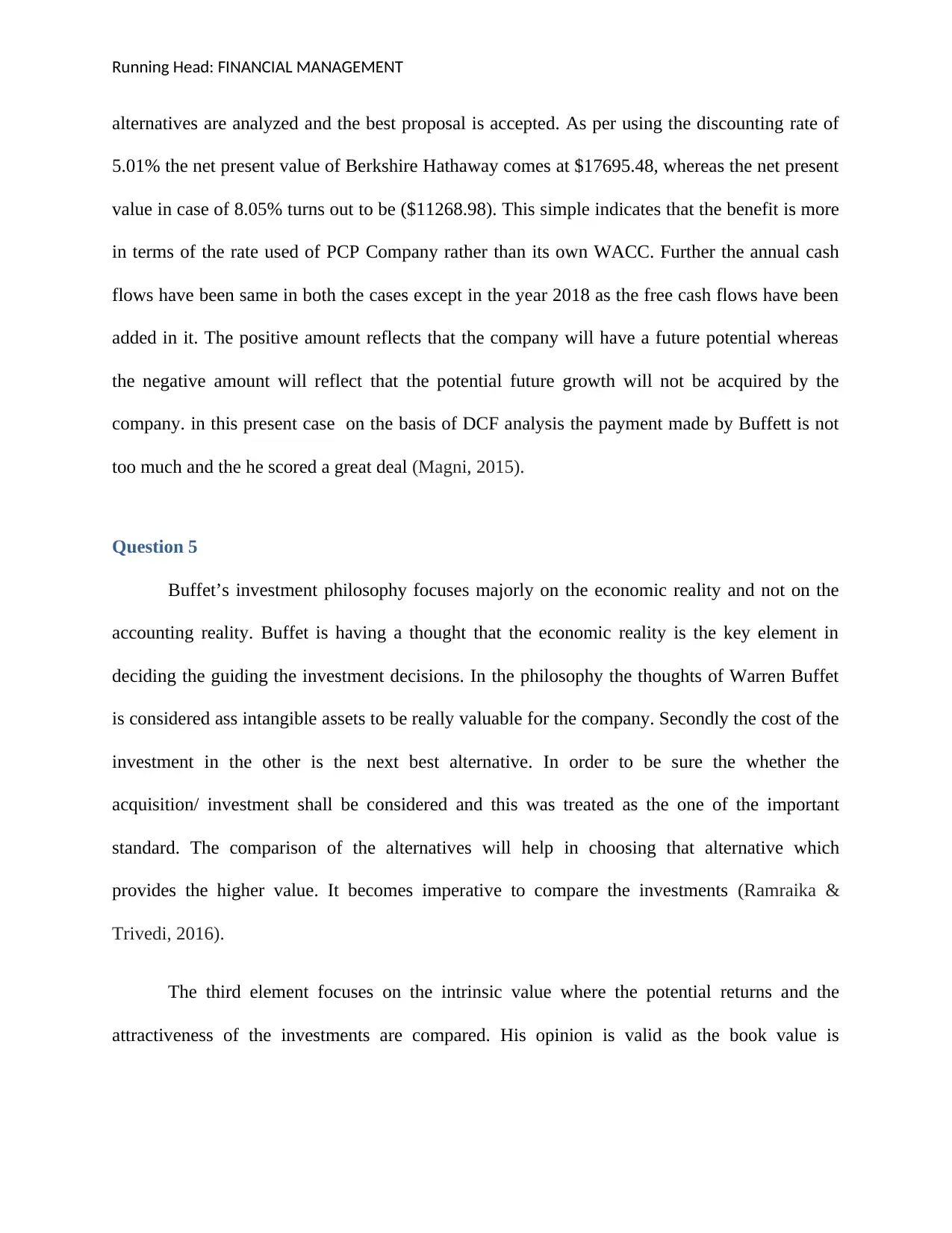
Running Head: FINANCIAL MANAGEMENT
alternatives are analyzed and the best proposal is accepted. As per using the discounting rate of
5.01% the net present value of Berkshire Hathaway comes at $17695.48, whereas the net present
value in case of 8.05% turns out to be ($11268.98). This simple indicates that the benefit is more
in terms of the rate used of PCP Company rather than its own WACC. Further the annual cash
flows have been same in both the cases except in the year 2018 as the free cash flows have been
added in it. The positive amount reflects that the company will have a future potential whereas
the negative amount will reflect that the potential future growth will not be acquired by the
company. in this present case on the basis of DCF analysis the payment made by Buffett is not
too much and the he scored a great deal (Magni, 2015).
Question 5
Buffet’s investment philosophy focuses majorly on the economic reality and not on the
accounting reality. Buffet is having a thought that the economic reality is the key element in
deciding the guiding the investment decisions. In the philosophy the thoughts of Warren Buffet
is considered ass intangible assets to be really valuable for the company. Secondly the cost of the
investment in the other is the next best alternative. In order to be sure the whether the
acquisition/ investment shall be considered and this was treated as the one of the important
standard. The comparison of the alternatives will help in choosing that alternative which
provides the higher value. It becomes imperative to compare the investments (Ramraika &
Trivedi, 2016).
The third element focuses on the intrinsic value where the potential returns and the
attractiveness of the investments are compared. His opinion is valid as the book value is
alternatives are analyzed and the best proposal is accepted. As per using the discounting rate of
5.01% the net present value of Berkshire Hathaway comes at $17695.48, whereas the net present
value in case of 8.05% turns out to be ($11268.98). This simple indicates that the benefit is more
in terms of the rate used of PCP Company rather than its own WACC. Further the annual cash
flows have been same in both the cases except in the year 2018 as the free cash flows have been
added in it. The positive amount reflects that the company will have a future potential whereas
the negative amount will reflect that the potential future growth will not be acquired by the
company. in this present case on the basis of DCF analysis the payment made by Buffett is not
too much and the he scored a great deal (Magni, 2015).
Question 5
Buffet’s investment philosophy focuses majorly on the economic reality and not on the
accounting reality. Buffet is having a thought that the economic reality is the key element in
deciding the guiding the investment decisions. In the philosophy the thoughts of Warren Buffet
is considered ass intangible assets to be really valuable for the company. Secondly the cost of the
investment in the other is the next best alternative. In order to be sure the whether the
acquisition/ investment shall be considered and this was treated as the one of the important
standard. The comparison of the alternatives will help in choosing that alternative which
provides the higher value. It becomes imperative to compare the investments (Ramraika &
Trivedi, 2016).
The third element focuses on the intrinsic value where the potential returns and the
attractiveness of the investments are compared. His opinion is valid as the book value is
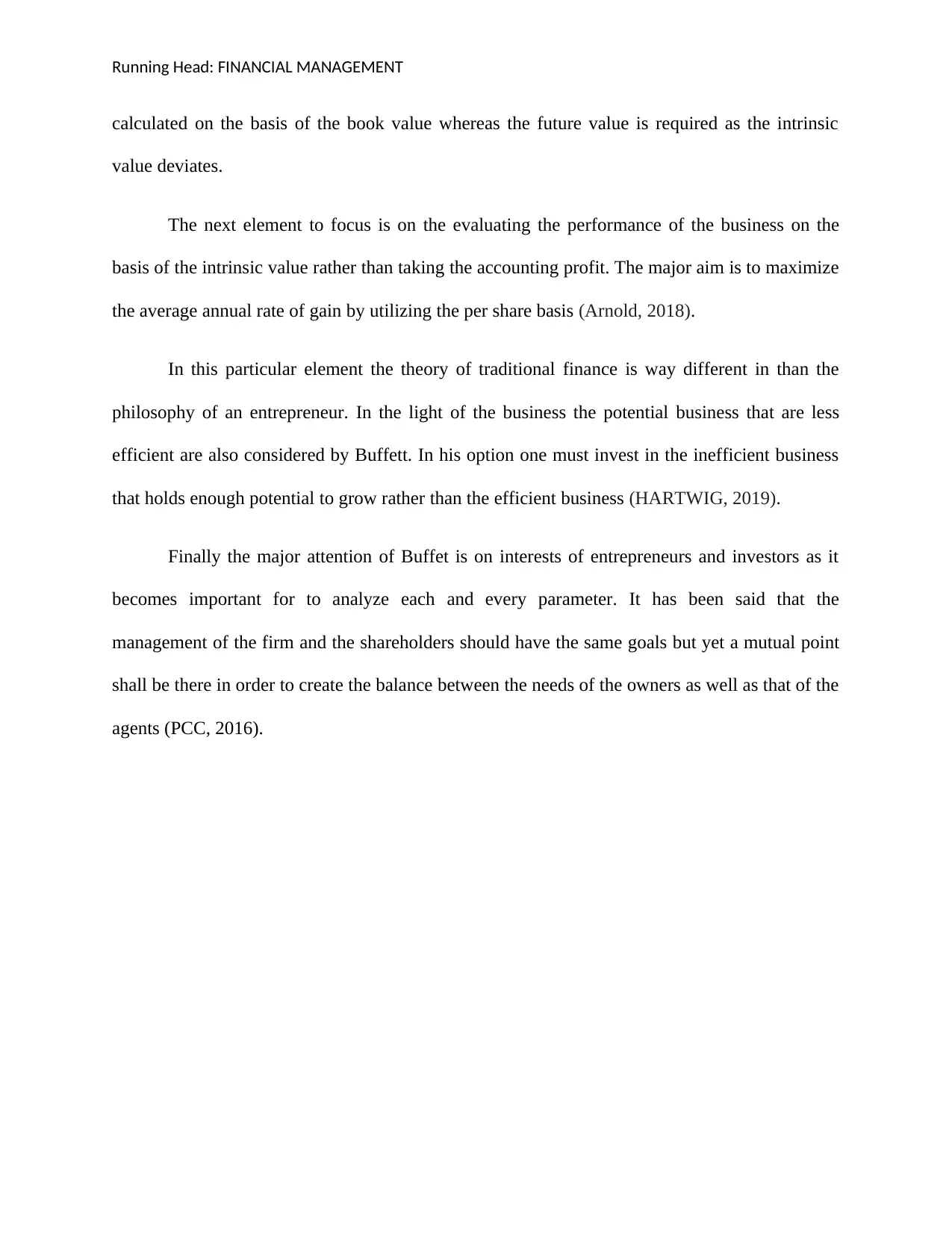
Running Head: FINANCIAL MANAGEMENT
calculated on the basis of the book value whereas the future value is required as the intrinsic
value deviates.
The next element to focus is on the evaluating the performance of the business on the
basis of the intrinsic value rather than taking the accounting profit. The major aim is to maximize
the average annual rate of gain by utilizing the per share basis (Arnold, 2018).
In this particular element the theory of traditional finance is way different in than the
philosophy of an entrepreneur. In the light of the business the potential business that are less
efficient are also considered by Buffett. In his option one must invest in the inefficient business
that holds enough potential to grow rather than the efficient business (HARTWIG, 2019).
Finally the major attention of Buffet is on interests of entrepreneurs and investors as it
becomes important for to analyze each and every parameter. It has been said that the
management of the firm and the shareholders should have the same goals but yet a mutual point
shall be there in order to create the balance between the needs of the owners as well as that of the
agents (PCC, 2016).
calculated on the basis of the book value whereas the future value is required as the intrinsic
value deviates.
The next element to focus is on the evaluating the performance of the business on the
basis of the intrinsic value rather than taking the accounting profit. The major aim is to maximize
the average annual rate of gain by utilizing the per share basis (Arnold, 2018).
In this particular element the theory of traditional finance is way different in than the
philosophy of an entrepreneur. In the light of the business the potential business that are less
efficient are also considered by Buffett. In his option one must invest in the inefficient business
that holds enough potential to grow rather than the efficient business (HARTWIG, 2019).
Finally the major attention of Buffet is on interests of entrepreneurs and investors as it
becomes important for to analyze each and every parameter. It has been said that the
management of the firm and the shareholders should have the same goals but yet a mutual point
shall be there in order to create the balance between the needs of the owners as well as that of the
agents (PCC, 2016).
⊘ This is a preview!⊘
Do you want full access?
Subscribe today to unlock all pages.

Trusted by 1+ million students worldwide
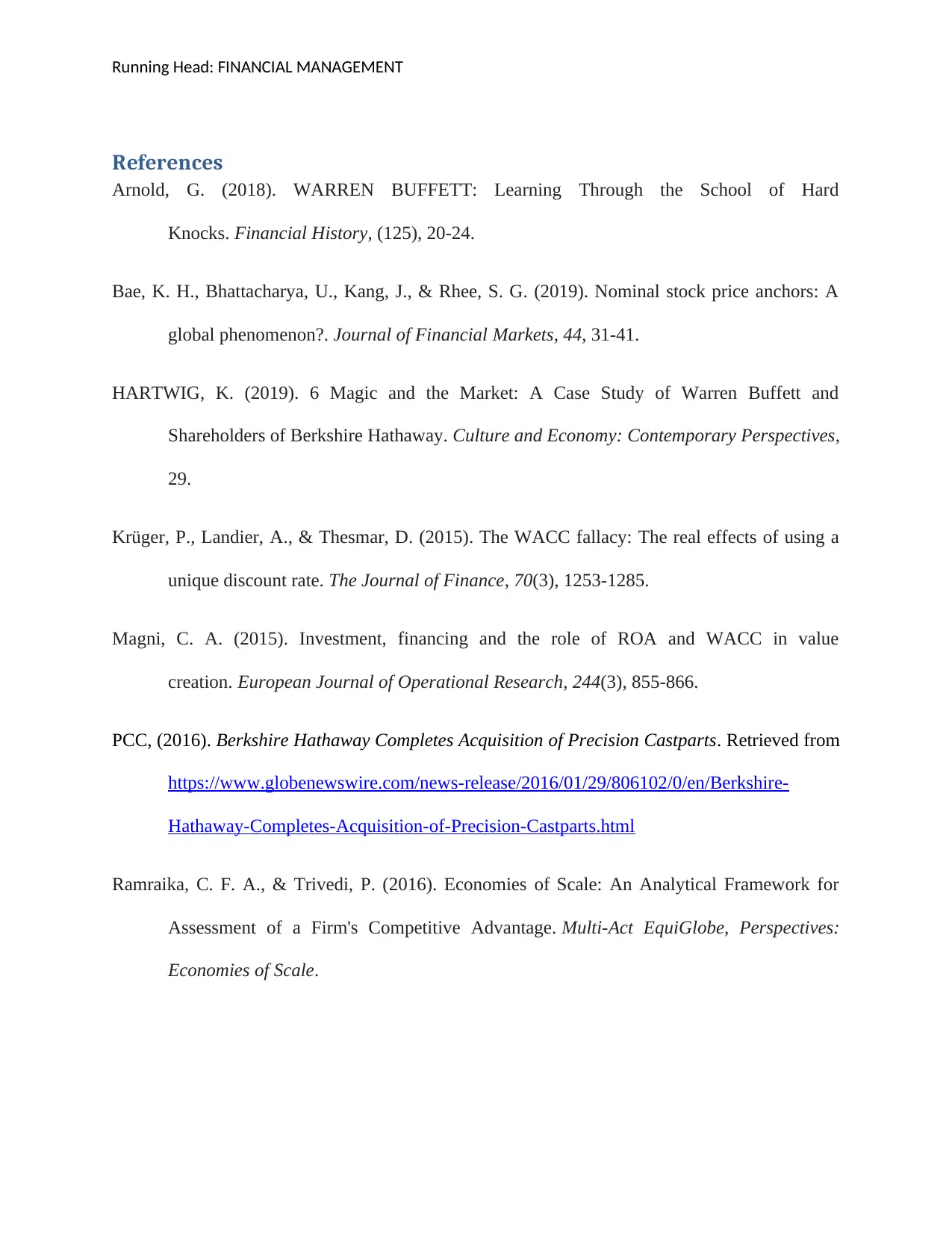
Running Head: FINANCIAL MANAGEMENT
References
Arnold, G. (2018). WARREN BUFFETT: Learning Through the School of Hard
Knocks. Financial History, (125), 20-24.
Bae, K. H., Bhattacharya, U., Kang, J., & Rhee, S. G. (2019). Nominal stock price anchors: A
global phenomenon?. Journal of Financial Markets, 44, 31-41.
HARTWIG, K. (2019). 6 Magic and the Market: A Case Study of Warren Buffett and
Shareholders of Berkshire Hathaway. Culture and Economy: Contemporary Perspectives,
29.
Krüger, P., Landier, A., & Thesmar, D. (2015). The WACC fallacy: The real effects of using a
unique discount rate. The Journal of Finance, 70(3), 1253-1285.
Magni, C. A. (2015). Investment, financing and the role of ROA and WACC in value
creation. European Journal of Operational Research, 244(3), 855-866.
PCC, (2016). Berkshire Hathaway Completes Acquisition of Precision Castparts. Retrieved from
https://www.globenewswire.com/news-release/2016/01/29/806102/0/en/Berkshire-
Hathaway-Completes-Acquisition-of-Precision-Castparts.html
Ramraika, C. F. A., & Trivedi, P. (2016). Economies of Scale: An Analytical Framework for
Assessment of a Firm's Competitive Advantage. Multi-Act EquiGlobe, Perspectives:
Economies of Scale.
References
Arnold, G. (2018). WARREN BUFFETT: Learning Through the School of Hard
Knocks. Financial History, (125), 20-24.
Bae, K. H., Bhattacharya, U., Kang, J., & Rhee, S. G. (2019). Nominal stock price anchors: A
global phenomenon?. Journal of Financial Markets, 44, 31-41.
HARTWIG, K. (2019). 6 Magic and the Market: A Case Study of Warren Buffett and
Shareholders of Berkshire Hathaway. Culture and Economy: Contemporary Perspectives,
29.
Krüger, P., Landier, A., & Thesmar, D. (2015). The WACC fallacy: The real effects of using a
unique discount rate. The Journal of Finance, 70(3), 1253-1285.
Magni, C. A. (2015). Investment, financing and the role of ROA and WACC in value
creation. European Journal of Operational Research, 244(3), 855-866.
PCC, (2016). Berkshire Hathaway Completes Acquisition of Precision Castparts. Retrieved from
https://www.globenewswire.com/news-release/2016/01/29/806102/0/en/Berkshire-
Hathaway-Completes-Acquisition-of-Precision-Castparts.html
Ramraika, C. F. A., & Trivedi, P. (2016). Economies of Scale: An Analytical Framework for
Assessment of a Firm's Competitive Advantage. Multi-Act EquiGlobe, Perspectives:
Economies of Scale.
Paraphrase This Document
Need a fresh take? Get an instant paraphrase of this document with our AI Paraphraser

Running Head: FINANCIAL MANAGEMENT
Stempel, J. (2015). Buffett pays high price for Precision Castparts. Retrieved from
https://www.reuters.com/article/us-precision-cast-m-a-berkshire-hatha/buffett-pays-high-
price-for-precision-castparts-idUSKCN0QD0LD20150810
Stempel, J. (2015). Buffett pays high price for Precision Castparts. Retrieved from
https://www.reuters.com/article/us-precision-cast-m-a-berkshire-hatha/buffett-pays-high-
price-for-precision-castparts-idUSKCN0QD0LD20150810
1 out of 8
Related Documents
Your All-in-One AI-Powered Toolkit for Academic Success.
+13062052269
info@desklib.com
Available 24*7 on WhatsApp / Email
![[object Object]](/_next/static/media/star-bottom.7253800d.svg)
Unlock your academic potential
Copyright © 2020–2026 A2Z Services. All Rights Reserved. Developed and managed by ZUCOL.





